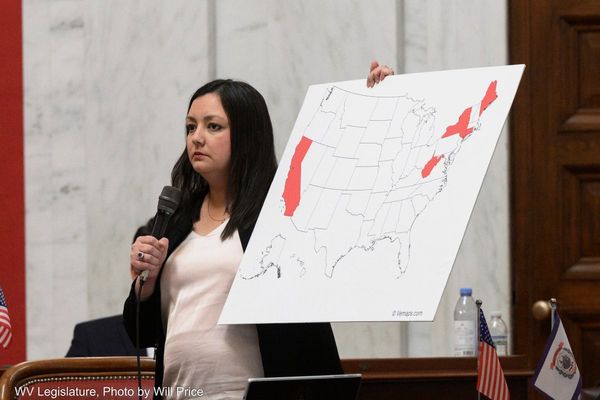
Greater Sydney is on high alert with the next 24 hours “absolutely critical” with torrential rain and flash-flooding forecast.
“Early tomorrow morning and throughout the day, we could see severe thunderstorms bringing heavy rain, damaging winds and possibly even large hail,” the Bureau of Meteorology’s Dean Narramore said on Wednesday.
The severe weather warning extends from Newcastle to the South Coast and there’s a flood alert for the Hawkesbury and Nepean rivers with residents warned they may need to evacuate.
Earlier, the Bureau of Meteorology pared back its earlier for the daily rain total from as much as 150mm to 200mm to 100mm to 150mm, but reissued its severe weather warning for damaging winds and torrential rainfall for a coastal region stretching from near Newcastle down to almost the Victorian border.
“Heavy rainfall which may lead to flash flooding is forecast to develop over parts of the Hunter and Metropolitan, Illawarra, South Coast and parts of Central Tablelands and Southern Tablelands Forecast Districts during Wednesday,” the bureau said. “Six-hourly rainfall totals between 80 and 120mm are likely.”
Severe Weather Update: major flooding ongoing; East Coast Low off NSW. Video current: 1.00pm AEDT 2 March 2022
— Bureau of Meteorology, Australia (@BOM_au) March 2, 2022
Know your weather, know your risk. For the latest forecasts and warnings, go to our website https://t.co/XaTtI3QlwZ or the #BOMWeather app. pic.twitter.com/U9rUW388DH
“Locally intense rainfall leading to dangerous and life-threatening flash flooding is possible with thunderstorms with six-hourly rainfall totals up to 200mm [are] possible,” the warning said, adding that wind gusts could surpass 90km/h along the coastal fringe.
East coast lows are intense weather systems that can include thunderstorms and generate dangerous surf. Weather models can struggle to pick how close the low will form near or on the coast and how long they will linger, leading to forecast changes.
The rain will extend the damage already inflicted on communities in Queensland and northern NSW, stretching emergency services and leaving a huge toll in lives lost and damage.
Roads are starting to get inundated with water in Richmond. This is College St, just near the centre of town, now virtually inaccessible. @GuardianAus @cait__kelly pic.twitter.com/h9LtkQCTuj
— Caitlin Cassidy (@caitecassidy) March 2, 2022
The NSW emergency services minister, Steph Cooke, said “Sydney is on high alert”.
She urged people to comply with evacuation warnings and orders, saying “the next 24-hours are absolutely critical”.
“While we’re all hoping for the very best, we must be prepared for the worst,” she said.
‘“Sydney is copping a battering … that will continue for some time.”
The focus for Sydneysiders remains on Warragamba Dam which is overflowing, threatening up to 130,000 homes in the Hawkesbury and Nepean area.
“All of our attention is on Warragamba Dam…and at this stage, we are expecting something similar to March 2021,” Cooke said.
SES commissioner Carlene York warned communities in the Hawkesbury-Nepean they must be prepared for the severe flooding.
“We are expecting this might be as bad as we saw last year,” she said.
Ben Domensino, a senior Weatherzone meteorologist, said uncertainty remained, with the low “pretty weak” but likely to strengthen as it moves westwards.
Accumulated rain totals range between 50mm and 300mm by the end of Thursday, underscoring the forecast challenges. Sydney’s heaviest falls would probably come late on Wednesday and into Thursday, Domensino said.
The bureau’s Sydney’s rainfall prediction for Thursday was increased to 50mm to 70mm, up from 30mm to 50mm forecast previously, indicating the low may take longer to move off into the Tasman Sea.
Thursday is also looking pretty dam for much of the NSW coast and the hinterland. @BOM_au pic.twitter.com/iwz0L6kGTU
— Peter Hannam (@p_hannam) March 1, 2022
Sydney’s main reservoir, Warragamba Dam, started to spill into the Hawkesbury-Nepean floodplain from 3am Wednesday, with flows expected to peak on Thursday, the government said.
The rain gauge at #Warragamba Dam has received over 120mm in the last 28 hours, with similar totals in other parts of the dam's catchment area. This includes 48mm in the last 2 hours. pic.twitter.com/y3du5u14hG
— Ben Domensino (@Ben_Domensino) March 2, 2022
The dam, which holds 80% of Sydney’s drinking water, started releasing water to give it some moderate “airspace” before the downpour. Even so, it had reached 99% capacity by Tuesday.
“The upper range of the predicted spill peak from Warragamba dam has increased overnight, though it remains at a rate still well below the spill experienced in March 2021,” WaterNSW said on Tuesday.
Several other dams were spilling or considered likely to as a result of the rain, WaterNSW said.
“Tallowa and Cordeaux Dams are already spilling and other Upper Nepean storages likely to spill in the days ahead include Nepean, Avon, and Cataract, along with Woronora Dam to Sydney’s south.”







